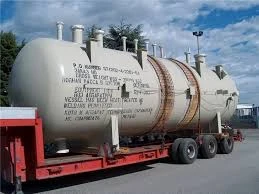
Comprehensive Technical Report on High-Pressure Vessels
Comprehensive Technical Report on High-Pressure Vessels (HPVs)
1. General Introduction: The Significance of High-Pressure Vessels (HPVs) 🌍
High-Pressure Vessels (HPVs) are indispensable components in modern industrial operations worldwide. They are containers designed to hold fluids (liquids or gases) at pressures significantly higher than the ambient environment (typically exceeding 15 psig).
1.1 Industrial Applications
HPVs serve critical functions across multiple industries, including:
Petrochemicals
Power Generation (nuclear and conventional)
Chemical Manufacturing
Oil Refineries
These vessels enable essential processes such as chemical reactions, gas separation, heat exchange, and large-scale storage under extreme conditions of high pressure and temperature.
1.2 Safety and Regulatory Framework
Because failure of HPVs can lead to catastrophic explosions or hazardous leaks, their design and operation are strictly regulated by international standards—most notably the ASME Boiler and Pressure Vessel Code, which ensures:
Structural integrity
Material quality
Safe fabrication methods
Continuous inspection and testing
2. Specific Case Study: High-Pressure Ammonia Vessel (30 Bar)
This section presents a case study of a high-pressure vessel designed for storing anhydrous ammonia (NH₃) at approximately 30 bar.
2.1 Design and Operational Specifications
| Item | Approximate Specification | Notes |
|---|---|---|
| Contained Medium | Anhydrous Ammonia (NH₃) | Toxic, corrosive liquid; prone to Stress Corrosion Cracking (SCC). |
| Design Code | ASME Section VIII, Division 1 | Standard international code for pressure vessel design. |
| Design Pressure | 30 bar (3.0 MPa) | Higher than operating pressure to ensure safety margin. |
| Material of Construction | Low-Sulphur Carbon Steel (ASTM A516 Gr. 70) | Offers excellent strength, ductility, and weldability. |
2.2 Approved Welding Methods and Procedures
Due to ammonia’s corrosive and embrittling characteristics, welding quality is critical to prevent failure.
| Welding Method | Primary Application | Special Ammonia-Service Requirements |
|---|---|---|
| Submerged Arc Welding (SAW) | Longitudinal and circumferential seams (for thickness ≥ 25 mm) | High deposition rate, deep penetration, excellent control for major seams. |
| Shielded Metal Arc Welding (SMAW) | Nozzles, manways, and root passes | Use low-hydrogen electrodes to prevent hydrogen embrittlement. |
3. Quality Assurance and Structural Integrity
Ensuring the long-term reliability of ammonia vessels involves precise heat treatment, stress control, and non-destructive testing to detect hidden flaws.
3.1 Heat Treatment and Stress Control (SCC Prevention)
Preheating:
Applied before welding (≥ 100 °C) to control cooling rate and minimize hardness in the Heat-Affected Zone (HAZ).
Post-Weld Heat Treatment (PWHT):
Required for ammonia service. The vessel is heated to 570 ± 20 °C to relieve residual stresses and prevent Ammonia Stress Corrosion Cracking (SCC).
3.2 Non-Destructive Testing (NDT) and Safety Devices

Hydrostatic Test:
Conducted with water at 1.5 × design pressure (≈ 45 bar) to verify strength and tightness.
Radiographic or Ultrasonic Testing (RT/UT):
100% inspection of all main welds to detect internal flaws.
Overpressure Protection:
Dual safety system using Safety/Relief Valves and Rupture Disks, arranged sequentially to prevent overpressurization.
4. Conclusion
The construction of a 30 bar high-pressure ammonia vessel demands full compliance with the ASME Code.
Key Success Factors:
Proper material selection (Low-Sulphur Carbon Steel)
Controlled welding procedures (SAW / Low-hydrogen SMAW)
Mandatory PWHT for SCC mitigation
Comprehensive NDT inspections
Through these measures, the vessel achieves maximum safety, reliability, and long service life under demanding operational conditions































![5 BEST Free Voice Recorder Apps for Students – Safe & Easy Download[2025 Guide]](https://amwcdn.com/featured/503211/conversions/e1216c4905-small-featured.webp)



